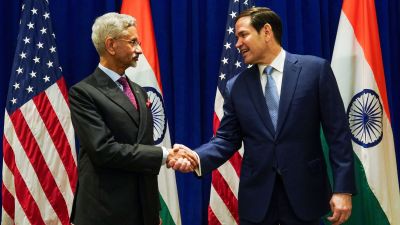Runs and Ruins
With the attendant baggage of emotions and expectations, perfect cricket during the current India-Pakistan was not high on anyone’s exp...

With the attendant baggage of emotions and expectations, perfect cricket during the current India-Pakistan was not high on anyone’s expectations. Yet the level of cricket played has proved correct those who believed that it would be a contest for hearts rather than heads, instinct over intellect and spunk over strategy. The average cricket fan revels in the excitement of close finishes; the true aficionado knows that these matches have involved few of the skills the two teams are blessed with.
In the din of run-making sprees and the occasional whisper of a ball beating the bat, basic cricketing common sense — on which the Aussies have a copyright — has taken a backseat. Instead of two Grandmasters hunched over 64 squares, this is a street fight between two professional heavyweight boxers. Instead of the Primera Liga, it’s a match in the Brazilian League.
Can you ever, for example, imagine John Buchanan on the balcony of the MCG, waving frantically to his No.7 batsman Michael Bevan to leave the stumps and hit the ball over the covers in the final over of a match? He would never need to. The man in the middle knows what to do — the scenarios have been discussed threadbare the previous night or much before that. In Karachi, and to a lesser extent Peshawar, Javed Miandad behaved like a pushy cricket dad and not the coach of a reputed international side.
Miandad’s histrionics are typical of the sub-continent’s cricketing culture (John Wright, bless him, is more restrained but his sphinx-like demeanour belies a man struggling to cope with Indian habits). Inadequate planning, inconsistency, an archaic mental make-up and lack of innovation have all been on display in the present series. And are in sharper focus because the series Down Under is still fresh in everyone’s minds.
Off the pace
Recall the way Australian rookies Brad Williams and Nathan Bracken bowled on those typically dead Indian tracks during the tri-series last year? Now switch to the wails emanating from Pakistan: dead tracks, batting tracks, nothing in it for the bowlers is the line trotted out. The flat-track excuse is as old as the hills — and the bowlers from these two countries, especially, should know better.
That’s half the problem; the other half is the sheer waywardness of the bowling. How can one explain the 90 extras (15 overs!) conceded by the bowlers in this series? If an international bowler — read Naved-ul Hasan — concedes 17 runs after bowling just one legitimate ball at the start of his spell, there’s something seriously wrong.
And before the Indians smirk, read this: the very first match of the series saw their bowlers unable to defend 335 against Pakistan’s second-string and mess up even after scoring 349 against their main team.
Special mention must be made of Zaheer Khan, India’s bowling spearhead, who has belied his years in international cricket by following, in his first 15 overs, a line apparently dependent on which side of the bed he got out of.
Same old style
Innovation has never been a sub-continental strength. India and Pakistan generally go by the book and if they don’t it can get ugly — or boring. Ganguly sticks to his seven-batsmen theory as if it was part of the MEA briefing while all hell breaks loose in Pakistan when Inzi backs his pace attack and opts to bowl first. Zaheer — despite all his opening spell follies — usually gets the red cherry first.
Batting orders are seldom changed since it is deemed to symbolise some sort of hierarchy — or worse, superstition — in the dressing room. Field settings come in three general styles – 0-15 overs, 15-40 and 40-50. Settings specific to batsmen or situations aren’t in vogue.
One bright spot this series has seen about 20 per cent of the batsmen getting out to slower balls bowled by the pacers. So are we catching up? Not really because, while the sub-continental bowlers have the usual ‘roll the fingers off-spin’ type of change in pace, the world has moved on to other innovations. Australian all-rounder Ian Harvey has at least four types of slower balls while veteran Kiwi ODI specialist Chris Harris is still adding to his six-an-over variety. Ganguly’s pace is similar to Harvey’s but his delivery is predictable and, ultimately, less threatening.
Batting without a plan
Why do both Pakistan and India fall at the final hurdle? The first two ODIs saw both teams, admittedly chasing high totals, falter at the death. Which shows a lack of planning because if you’ve been chasing, as Pakistan did, 7 runs per over for around 48 overs, you should be able to get nine off the last. Yet Pakistan failed at Karachi.
The exception was at Peshawar, where Moin stepped up the scoring rate around the 40th over to avoid tension later on.
Photos


- 01
- 02
- 03
- 04
- 05





























